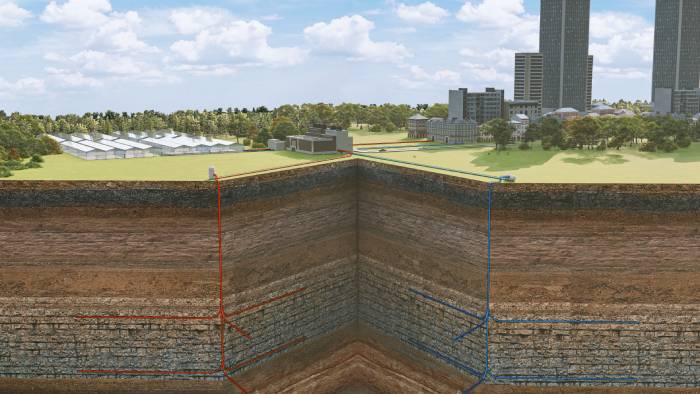
Geothermal energy, a renewable and clean energy source, harnesses the heat generated within the Earth. This type of energy can be accessed via sources like geysers and hot springs and used for heating structures or generating electricity.
- Although widely available, geothermal energy’s potential is only partially untapped.
- Costs have been a huge barrier, but geothermal technology is cheaper than before.
- The Netherlands and China are actively expanding their geothermal energy intake.
Geothermal energy is a type of energy derived from the inherent heat of the Earth. The Earth’s core, which reaches temperatures exceeding 5,000°C, generates this heat as a result of radioactive decay. This heat is then accessed through geysers, hot springs, and hydrothermal vents, which release hot water or steam. The heat can then be utilized directly for heating buildings or converted into electricity.
The global impact and potential of geothermal energy
Geothermal energy’s potential is immense and is already being harnessed worldwide. Countries like Iceland rely heavily on geothermal energy due to their abundant hot underground water. In contrast, nations like the United States must drill for geothermal energy, incurring higher costs. Nevertheless, the decreasing cost of geothermal technology is making it more economically viable for individuals and companies.
Moreover, geothermal energy provides several advantages over other renewable sources. It is a baseload energy source, meaning it can operate continuously regardless of external factors such as sunlight or wind availability. Additionally, geothermal systems are more land-efficient compared to other power plants.
Geothermal energy in the Netherlands
In the Netherlands, geothermal energy is being considered as an alternative to gas for heating buildings. The City of Amsterdam, Eneco, and Vattenfall have been researching new sources of geothermal heat, with the potential to connect 2 to 2.5 million homes to heat networks in the future. The stability and sustainability of geothermal energy make it an attractive option, and it also offers the Netherlands a chance to reduce reliance on other countries for heat supply.
However, concerns such as groundwater contamination and the cost of test drillings and building heat networks need to be addressed. Despite these challenges, the benefits of geothermal energy, including its integration into a larger heat network encompassing waste heat from data centres and solar thermal heat, are believed to outweigh the drawbacks.

China’s geothermal energy progress
China, the world’s largest energy consumer, is also seeking to expand the use of geothermal energy. The Chinese government plans to increase the scale of wind and solar power projects while advancing the construction of nuclear power plants. In addition, Sinopec, a state-owned refiner, aims to add 75 million square meters of geothermal heating area by the end of 2025.
Boosting clean power sources like geothermal energy in China’s northern regions has contributed to improving air quality. The National Energy Administration of China has proposed increasing the geothermal heating-cooling area by 50 percent in five years, doubling geothermal power generation capacity.

Advancements in geothermal energy
Artificial Intelligence (AI) and innovative techniques are playing a significant role in enhancing the efficiency and productivity of geothermal energy. For instance, TNO, the main Dutch research organisation, has developed an AI application for geothermal energy systems. This application extracts new insights from real-time data, improving decision-making and preventing breakdowns in geothermal plants.
Furthermore, Penn State scientists have proposed a fracture conductivity tuning technique to improve the efficiency of geothermal power plants. This technique involves adding materials or chemicals to the water injected into geothermal reservoirs. This allows for more uniform heat extraction and prevents shortcuts that allow cooler water to rush to the production wells.
Geothermal energy’s continuous availability, coupled with advancements in technology and increased global adoption, underscores its potential to become a leading source of clean and renewable energy.

